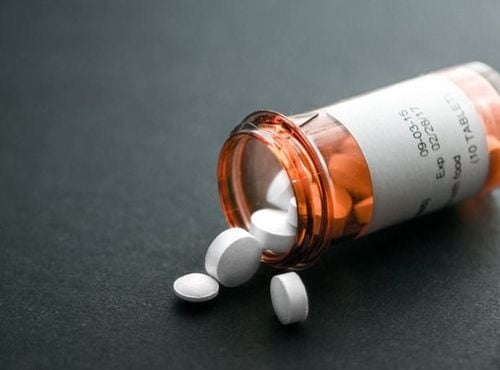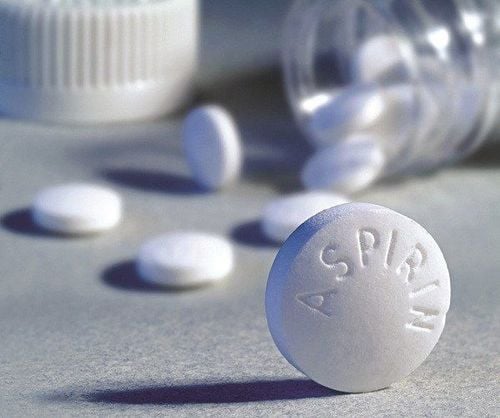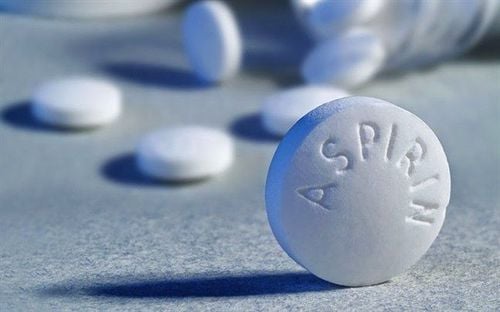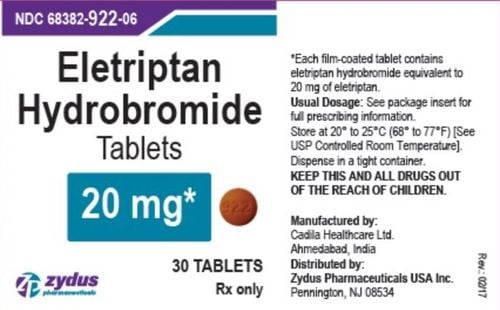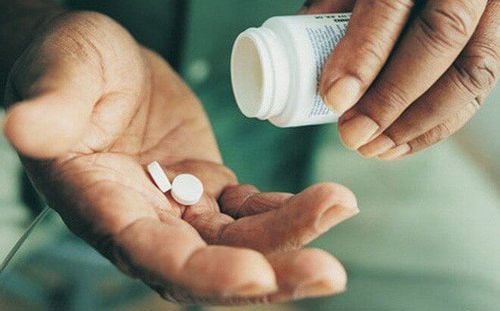This is an automatically translated article.
Rivaxored 10mg is an anticoagulant, used as a way to prevent blood clots from forming in people at high risk. Thereby, helping to reduce the risk of damage from blood clots.1. What is Rivaxored 10mg?
Rivaxored 10mg has the main ingredient is Rivaroxaban 10mg, is made in the form of tablets.
Rivaroxaban is a highly selective and direct inhibitor of clotting factor Xa. Inhibition of factor Xa disrupts endogenous and exogenous coagulation, inhibits the activation of prothrombin (factor II) to thrombin (factor IIa) and the development of thrombus. Rivaroxaban does not directly inhibit thrombin (factor IIa) and has no effect on platelets.
2. Indications and contraindications of Rivaxored 10mg
Rivaxored is indicated for the treatment of the following conditions:
Helps prevent venous thromboembolism (VTE) in adult patients undergoing elective hip or knee replacement surgery. Helps prevent stroke for people with risk factors. Prevention of blood clots in deep vein thrombosis (DVT). These blood clots can lead to travel to the lungs, causing a pulmonary embolism. Preventing deep vein thrombosis after hip or knee replacement surgery Reduces the risk of major heart problems such as heart attacks in people with chronic coronary artery disease (CAD) or peripheral artery disease (PAD) ) Contraindications:
Rivaxored 10mg is contraindicated in the following cases:
Patients with hypersensitivity to the active ingredient rivaroxaban or any of the excipients of the drug. The patient is clinically significant bleeding. Have injury or have a medical condition that poses a serious bleeding risk including: current or recent gastrointestinal ulceration, presence of malignancy, recent brain or spinal cord, spine or eye damage, Recent intracranial hemorrhage... Relative contraindications: Co-administration with anticoagulants such as unfractionated heparin (UFH), low molecular weight heparin, heparin derivatives (Fondaparinux, etc.) ), oral anticoagulants (Warfarin, Dabigatran Etexalate, Apixaban, etc...). Liver disease associated with coagulopathy and clinically relevant bleeding risk includes cirrhotic patients with Child Pugh B and C ratings. Pregnancy and breast-feeding.
3. Dosage and administration of Rivaxored 10mg
3.1 How to take Rivaxored 10mg is a film-coated tablet for oral administration. The drug can be taken with or without food. In case the patient cannot swallow the tablet whole, it can be crushed and mixed with water or soft food before eating or drinking.
3.2 Dosage Adults:
Usual dose for prevention of venous thromboembolism (VTE):
The recommended dose is 1 tablet taken once daily. The starting dose should be given within 6-10 hours after surgery, provided bleeding has been stopped. The duration of treatment depends on the individual patient's risk of venous thrombosis. For patients undergoing major surgery such as hip replacement, the recommended duration of treatment is usually 5 weeks. For patients undergoing major knee surgery, the recommended duration of treatment is usually 2 weeks. Dosage in the prevention of stroke and systemic embolism:
The recommended dose is 2 tablets once daily, which is also the maximum recommended dose. When patients treated with rivaroxaban should be maintained on the drug long-term, as this will give the benefits of stroke and systemic embolism outweigh the risk of bleeding. Usual Dosage for VTE or Prevention:
The recommended dose for initial treatment is 15 mg twice daily for the first three weeks, then 20 mg once daily. for further treatment Duration of drug therapy should be individualized after a careful assessment of the therapeutic benefit against the risk of bleeding. Patients with Impaired Renal Function: Limited clinical data are available in patients with severe renal impairment (creatinine clearance 15–29 ml/min) showing significantly increased plasma concentrations of rivaroxaban. Therefore, Rivaroxaban should be administered with caution to these patients. Its use is not recommended in patients with creatinine clearance < 15 ml/min. Dosage depends on the severity of the disease and on the creatinine clearance. No dose adjustment is required in patients with mild renal impairment (creatinine clearance 50-80 ml/min).
Children: The efficacy and safety of rivaroxaban for children under 18 years of age have not been established. Therefore, rivaroxaban should not be used in children under 18 years of age.
4. Side effects of the drug Rivaxored 10mg
When using Rivaxored 10mg, you may experience undesirable effects:
Blood and lymphatic system disorders: Anemia is common. Less commonly, thrombocytosis (including increased platelet count). Immune system disorders: Rarely causes allergic reactions and atopic dermatitis. Nervous system: commonly causes dizziness, headache; Rarely causes cerebral and intracranial hemorrhage, syncope. Eyes: Eye hemorrhage is common; Common tachycardia, hypotension, hematoma; Nosebleeds, coughing up blood; Bleeding gums, gastrointestinal bleeding (including rectal bleeding), abdominal and gastrointestinal pain, dyspepsia, nausea, constipation, diarrhea, vomiting. Uncommon is dry mouth; Abnormal liver function and jaundice rarely. Itching, rash, subcutaneous haemorrhage, cutaneous and subcutaneous haemorrhage are common signs; urticaria is not common. Pain in the extremities; Genitourinary tract bleeding, renal failure (including increased blood creatinine, increased blood urea; fever, peripheral edema, decreased strength and energy; increased liver enzymes are common side effects. medication, if serious, the patient should stop using and notify the doctor or go to the nearest medical facility for timely treatment.
5. Note when taking Rivaxored 10Mg
Before using the drug, carefully read the instructions for use of the drug and inform the doctor about any medical conditions or allergies to the drug.
Risk of bleeding: As with other antithrombotic agents, rivaroxaban should also be used with caution in patients with signs of bleeding. Rivaroxaban should be discontinued if major bleeding occurs.
For people with liver problems: this medicine should not be taken if you have moderate to severe liver disease or liver disease related to bleeding problems . For people with prosthetic heart valves: Do not take this medicine if you have an artificial heart valve, as it has not been studied specifically in people with artificial heart valves. For people with antiphospholipid syndrome (APS): This medicine should not be taken if you have APS. This medicine may increase your risk of serious blood clots or stroke. People who are positive for all three antiphospholipid antibodies may have an increased incidence of recurrent blood clots. For the elderly: The risk of stroke and bleeding increases with age, but the benefits of using this medicine in the elderly may outweigh the possible risks. Risk of thrombosis after early discontinuation of anticoagulants. If rivaroxaban needs to be discontinued, consider an alternative anticoagulant. Ensure continued anticoagulation during the transition to another anticoagulant to minimize the risk of bleeding.
Interactions with other drugs when using:
Rivaroxaban is not recommended for patients taking azole antifungals (such as Ketoconazole, Itraconazole, Voriconazole and Posaconazole) or HIV protease inhibitors. eg Ritonavir). These drugs strongly inhibit both CYP3A4 and P-gp. As this may increase the plasma concentration of rivaroxaban to a level that may increase the clinical risk of bleeding, fatal bleeding may occur. Caution should be exercised in patients receiving concomitant medications that affect hemostasis such as nonsteroidal anti-inflammatory drugs (NSAIDs), acetylsalicylic acid (ASA) and drugs with antiplatelet effects. For patients at risk for peptic ulcer disease, appropriate preventive treatment should be considered. Concomitant use with SSRIs and SNRIs because these drugs may increase the risk of bleeding. Concomitant use of rivaroxaban with a strong inducer of CYP3A4 (rifampicin, phenobarbital, barbiturates, phenytoin) may lead to decreased blood concentrations of rivaroxaban, a decrease in the pharmacodynamic effects of rivaroxaban and the risk of blood clot formation. Above is the information that you can trust about the drug Rivaxored 10mg. The drug is used under the doctor's prescription, not arbitrarily taking the drug, nor stopping taking it on your own. During the course of taking the drug, if you notice any abnormalities, you should immediately notify your doctor.
Please dial HOTLINE for more information or register for an appointment HERE. Download MyVinmec app to make appointments faster and to manage your bookings easily.




